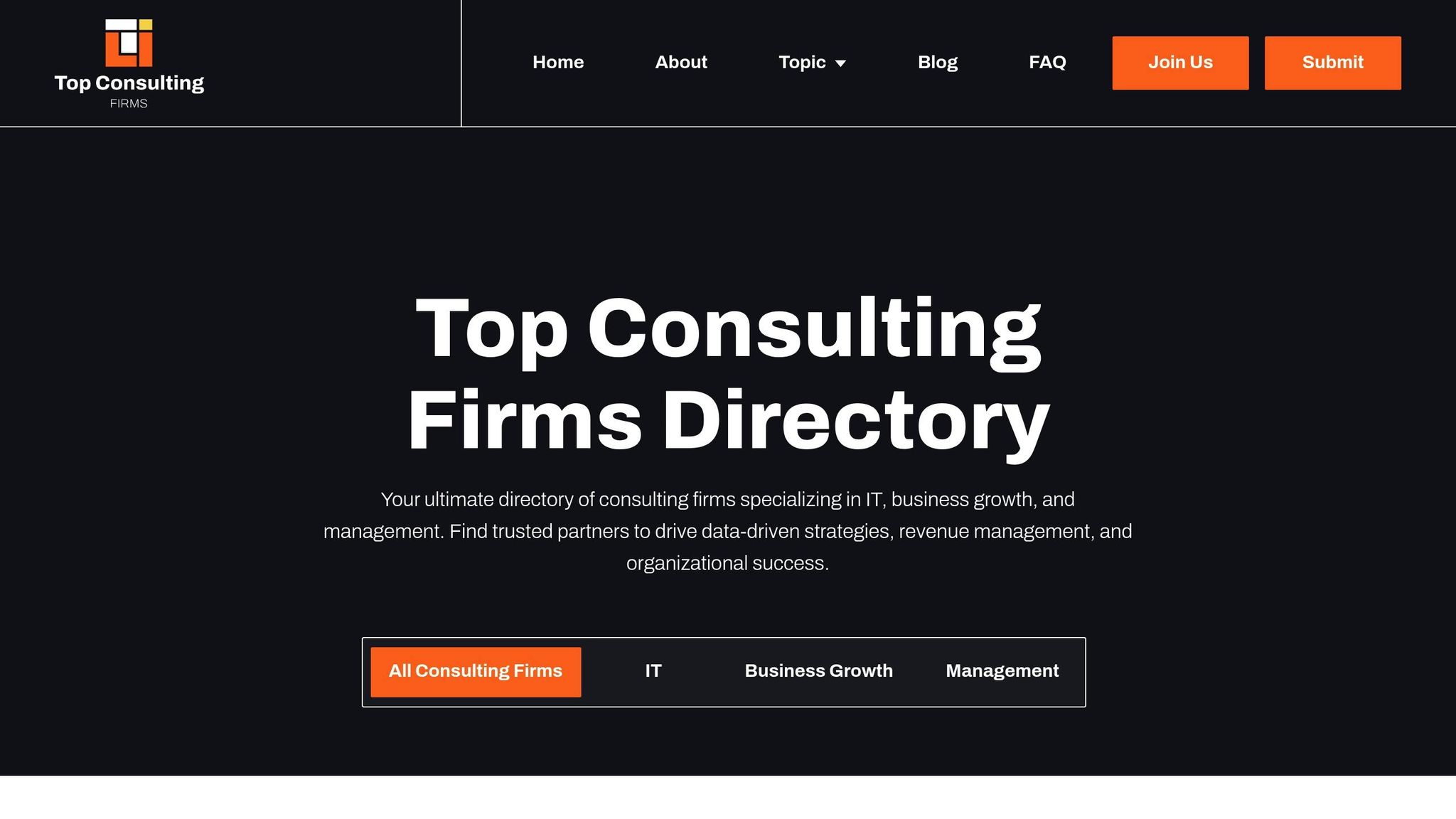Tracking progress in digital transformation can be tricky, but quantitative benchmarking offers a clear way forward. By focusing on measurable data like system uptime, user adoption rates, and ROI, businesses can compare their performance against peers, identify gaps, and improve efficiency.
Key takeaways from this article:
- What it is: Quantitative benchmarking uses metrics to evaluate digital transformation efforts objectively.
- Why it matters: Companies using benchmarking report up to 20% higher revenue growth and 10-15% efficiency improvements.
- How it works: Methods include performance metric analysis, internal and external comparisons, and robust data collection.
- Challenges: Issues like poor data quality, high costs, and context differences can limit effectiveness.
- Solutions: Partnering with expert consultants and setting actionable KPIs tailored to business goals helps maximize results.
With a structured approach, benchmarking not only tracks progress but also drives better decision-making and long-term success.
Benchmarking Organization's Maturity For Digital Transformation
Main Quantitative Benchmarking Methods
Quantitative benchmarking provides structured ways to measure progress in digital transformation, tailored to your specific goals and available data.
Performance Metric Analysis
At the heart of quantitative benchmarking is performance metric analysis, which focuses on key performance indicators (KPIs), return on investment (ROI), and digital adoption rates. This method translates transformation goals into measurable results.
The best organizations track both leading and lagging indicators to get a full picture of performance. For instance, employee training completion rates are a leading indicator, hinting at potential productivity boosts. On the other hand, actual productivity improvements are lagging indicators, showing the results of past efforts.
Finance teams are a great example of this approach in action. They often benchmark their performance using historical data and comparisons with peer groups. While lagging indicators like cost savings or revenue growth are common, leading indicators help explain the reasons behind their successes or shortfalls.
When choosing metrics, focus on those directly tied to business outcomes. Examples include revenue per employee, customer acquisition costs, and system uptime percentages. These provide a clear view of transformation progress. Metrics must also be easy to access, consistent, and dependable.
Digital adoption rates are especially important in transformation projects. Keep an eye on metrics like user login activity, feature usage, and the time it takes employees to become proficient with new systems. These numbers reveal whether your new tools are streamlining operations or complicating workflows.
Beyond individual metrics, comparing processes across organizations can sharpen your insights even further.
Comparative and Process Benchmarking
Comparative benchmarking evaluates your organization's performance against others, helping to uncover areas for improvement. This method comes in two forms: internal benchmarking, which compares performance across departments or functions within your company, and external benchmarking, which looks at your performance relative to industry peers using third-party data.
Internal benchmarking works well in large companies with multiple divisions pursuing similar digital initiatives. Comparing results like adoption rates, cost savings, or efficiency improvements across teams can highlight best practices within your organization.
External benchmarking, on the other hand, provides a broader perspective. It helps you see where competitors are excelling and where you might be falling behind.
"IT benchmarking highlights specific areas where peers have made progress or where the organization has overlooked opportunities for improvement." - ITIL 4 Direct Plan and Improve publication
Several services can assist with benchmarking. For example, Gartner offers IT Score for CIOs, covering 30 functional activities across 7 objectives. Similarly, IDC Global provides benchmarks on areas like cloud economics, IT service cost management, and supplier performance.
The benchmarking process typically involves several steps: selecting a focus area, identifying benchmark partners, documenting processes, collecting data, analyzing performance, and implementing improvements. When choosing benchmark partners, consider organizations excelling in areas relevant to your goals - not just direct competitors. Insights from other industries can often provide fresh ideas for solving shared challenges.
Accurate and thorough data collection is key to making these comparisons meaningful.
Data Collection and Analysis
Effective benchmarking relies on gathering high-quality data from both internal and external sources to create a full picture of your transformation progress. The depth of your analysis depends on having detailed and relevant data from various points.
Internal data collection involves tapping into system records, employee surveys, and reports. Tools like CRM systems, ERP platforms, and collaboration software generate ongoing performance data.
External data collection uses resources like industry databases, market research, and third-party benchmarking services. For example, Kyriba’s liquidity benchmarking database includes over 1,600 organizations categorized by revenue, industry, location, and business processes. These external datasets provide valuable context for your internal metrics and highlight broader trends.
| Data Source Type | Examples | Best Used For |
|---|---|---|
| Internal Systems | CRM, ERP, collaboration tools | Tracking adoption and efficiency |
| Employee Surveys | Training feedback, satisfaction scores | Understanding workforce adaptation |
| External Databases | Industry reports, peer benchmarks | Competitive positioning |
| Third-party Services | Gartner IT Score, IDC benchmarks | Professional validation |
Once data is collected, the next step is to analyze it by comparing your metrics to benchmark values. Look for performance gaps - areas where your numbers fall short of industry standards. These gaps pinpoint where improvement efforts can make the biggest difference.
Modern tools like data lakes simplify real-time analytics, handling diverse data types without the constraints of traditional data warehouses. Continuous monitoring systems are crucial for tracking KPIs over time, providing a dynamic view of your progress rather than relying on occasional snapshots. Automating data collection and organization with tracking tools can save time and improve accuracy. Regularly sharing insights with your team fosters a culture of ongoing improvement.
How to Implement Quantitative Benchmarking
When it comes to digital transformation, having a clear plan for quantitative benchmarking can make all the difference. Studies show that more than 70% of digital initiatives fail due to unclear goals and poor tracking, with half of businesses skipping proper KPIs altogether. To avoid these common issues, it’s crucial to follow a structured process. Below, we'll walk through how to choose benchmarks, define actionable metrics, and keep track of progress effectively.
Finding the Right Benchmarks
The first step in effective benchmarking is to focus on business goals rather than just technical metrics. Shifting from IT-focused measurements to KPIs that align with business outcomes is essential for tracking the success of digital transformation.
Collaborate with your team to define what success looks like from a business perspective. This ensures benchmarks represent actual value rather than just technical performance. For example, instead of simply tracking system uptime, think about how that uptime impacts customer satisfaction or protects revenue.
Industry-specific benchmarks are particularly useful for meaningful comparisons. As Paul Proctor, Distinguished VP Analyst at Gartner, points out:
"KPIs need to be industry-specific and then organization-specific to be meaningful and useful."
Comparing your performance to industry peers and competitors can help you identify strengths and pinpoint areas for improvement. This external perspective provides valuable insights into your position relative to market leaders.
It’s also important to consider your organization’s current maturity level. Setting realistic goals based on where you are now prevents overwhelming your team with unattainable targets. For instance, a manufacturing company just starting its digital journey shouldn’t aim to match the benchmarks of a tech-native company but should instead look at similar manufacturers at a comparable stage of transformation.
Finally, tailor benchmarks to their intended audience. Different departments, such as finance and customer service, will require distinct benchmarks that align with their specific goals. Clearly link each benchmark to a desired business outcome to ensure relevance and applicability.
Choosing and Normalizing Metrics
Selecting the right metrics is about finding a balance between practicality and coverage. Paul Proctor from Gartner advises:
"Choose KPIs that you can measure easily. Don't try to build a KPI hierarchy. Select just 5 to 9 metrics to track, report and act on. The value of a metric lies in its ability to influence business decision making."
Focus on metrics that are straightforward and understandable to everyone in the organization, not just IT staff. This makes it easier to gain company-wide support for your benchmarking efforts. For financial metrics, use U.S. currency formatting (e.g., $1,234.56), stick to MM/DD/YYYY for dates, and apply imperial units for measurements.
When normalizing data, ensure consistent calculation methods across teams and time periods. For example, if you’re measuring customer acquisition cost, all departments should include the same types of expenses and use matching timeframes. Consistency is key for accurate comparisons and trend analysis.
To create meaningful KPIs, ask these five questions: What are we measuring? Where are we now? What is our target? What business outcome are we aiming for? What is the balance point between effort and impact? This approach ensures that each metric serves a clear, actionable purpose.
Avoid vanity metrics - those that look good on paper but don’t drive decisions. For instance, tracking how many employees have been trained on new software is less impactful than measuring how quickly they become proficient with it.
Deloitte’s research highlights that 81% of organizations consider productivity their top measure of digital transformation ROI. They also identified 46 different KPIs related to digital transformation, showing the wide range of options available. Choose metrics that align with your specific goals rather than relying on generic lists.
Once benchmarks and metrics are in place, the next step is to monitor and refine them as your business evolves.
Tracking and Updating Benchmarks
To stay on track, continuous monitoring and regular updates are essential. Companies that actively track their transformation progress are 70% more likely to achieve their goals.
Start by establishing clear baselines and reviewing progress monthly or quarterly. Use data visualization tools to simplify complex information and identify trends. Modern dashboards can automate much of this process, alerting you to significant changes that need attention. Look for tools that are scalable, user-friendly, and tailored to your needs.
As your transformation progresses, reassess your objectives and KPIs to ensure they remain relevant. What’s important at the beginning of your journey may shift as you achieve milestones. Incorporate benchmark tracking into decision-making processes to maintain agility and focus.
Provide training to help employees understand new tracking tools and foster a data-driven mindset. When team members see how their work contributes to achieving benchmarks, they’re more likely to engage with the transformation process.
Encourage your team to view adjustments to benchmarks as part of the natural evolution of transformation, not as failures. This mindset supports the iterative nature of digital transformation and keeps momentum strong throughout the journey.
sbb-itb-97f6a47
Benefits and Drawbacks of Quantitative Benchmarking
This section dives into the upsides and challenges of quantitative benchmarking, a method that relies on data-driven insights to guide decision-making. By weighing its advantages and limitations, organizations can better determine how to integrate benchmarking into their digital transformation strategies.
Quantitative benchmarking stands out for its ability to provide clear, measurable data. Numbers tell a straightforward story, cutting through subjective interpretations. For instance, in 2017, BNY Mellon's fund transfer bots saved $300,000 annually by reducing data errors and speeding up payment processing. This concrete result not only justified the initial investment but also laid the groundwork for future automation projects.
Once a benchmarking framework is in place, it can be applied across various departments, creating consistency. HypoVereinsbank demonstrated this by using IBM OpenPages software to automate reporting for over 3,000 internal controls, which led to a 33% reduction in staffing needs.
Another major advantage is its role in competitive analysis. Benchmarking helps organizations see where they stand in the market. For example, a study of 80 global banks from 2018 to 2022 revealed that digital leaders achieved annual total shareholder returns of 8.1%, compared to 4.9% for those lagging behind. This type of external perspective can uncover opportunities that internal metrics alone might miss.
However, quantitative benchmarking isn’t without its challenges. A key hurdle is data quality. Only 61% of organizations report having accurate people-related data, which means that comparisons can sometimes be misleading. Incomplete or outdated data can distort the insights gained.
Another issue is that raw numbers don’t always tell the whole story. For instance, a global investment bank using Fenergo’s workflow platform reduced case-handling time by 37% - from 27 hours to 16.47 hours. Impressive as that sounds, it doesn’t reveal whether customer satisfaction improved or if new risks arose.
The "apples-to-apples" problem is another complication. Differences in company size, industry regulations, and operational contexts can make benchmarks irrelevant for some organizations. Plus, the costs of implementing benchmarking tools can be steep, with software fees ranging from tens of thousands to millions of dollars. While some companies see returns of $5–$10 for every dollar spent on transformation efforts, the upfront investment can be a significant barrier, particularly for smaller businesses.
Comparison Table: Pros and Cons
Here’s a quick overview of the benefits and challenges of quantitative benchmarking:
| Benefits | Drawbacks |
|---|---|
| Objective measurement – Provides clear, data-driven insights that cut out guesswork | Data quality issues – Incomplete or outdated data can lead to misleading results |
| Scalable framework – Can be applied consistently across departments and business units | Missing context – Numbers alone don’t capture organizational nuances |
| Competitive intelligence – Highlights market positioning and improvement opportunities | Comparison challenges – Differences in size and context make direct comparisons tricky |
| Efficiency gains – Reduces operational costs and streamlines processes | High implementation costs – Software fees can range from thousands to millions of dollars |
| Strategic planning – Helps set clear, measurable goals for improvement | Static snapshots – Benchmarks may not reflect ongoing changes in the business environment |
| Cross-industry insights – Offers perspectives beyond your immediate sector | Resistance to change – Organizations may push back against necessary adjustments |
| ROI visibility – Companies with strong measurement practices are 30% more likely to meet financial goals | Confidentiality concerns – Partners may hesitate to share sensitive data |
Experts stress that organizations shouldn’t rely solely on benchmarking as their roadmap. Instead, it should be one piece of a broader strategy. By combining quantitative data with qualitative insights and tailoring findings to their specific needs, companies can make more informed decisions. Notably, 89% of large organizations undergoing digital transformation agree that even imperfect measurement is better than operating without clear insights. This highlights the value of pairing data-driven benchmarking with expert advice to achieve meaningful progress.
Using Consulting Expertise to Improve Benchmarking
Quantitative benchmarking provides clear metrics, but many organizations struggle with selecting the right metrics, gathering accurate data, and making sense of the results. It's no surprise, then, that 70% of digital transformations fail due to insufficient expertise and poor change management. This highlights why more businesses are turning to consulting professionals, who bring proven methods and industry know-how to the table.
Specialized consulting firms step in to address these challenges with targeted expertise.
How Top Consulting Firms Support Benchmarking
Consulting firms provide expertise in areas like data analytics, digital strategy, and benchmarking implementation. Their external perspective helps uncover blind spots and opportunities that internal teams might miss. These firms are skilled at helping businesses understand industry standards, pinpoint weaknesses, and implement meaningful improvements. Their strengths include technology integration, data analysis, change management, and digital strategy.
Take Bain & Company, for example. They worked with a European power producer to implement a Customer Experience Index and an AI-driven Next Best Action engine. By integrating data from 25 sources into 500 customer metrics, they enabled over 30 prioritized actions, quadrupled the success rate, and increased active customers by 10%.
Consulting firms also deliver tailored solutions in areas such as artificial intelligence, cloud computing, cybersecurity, and data analytics. They ensure smooth adoption of new technologies by integrating change management processes and equipping employees with the necessary skills.
As Pattem Digital describes their approach:
"At Pattem Digital, we don't just analyze; we coach an enterprise through the whole improvement cycle. Our expertise enables organizations to not only master the nuances of competitive benchmarking but also identify their weaknesses and build a roadmap of concrete steps to strengthen that entity."
When choosing a consulting firm for benchmarking, businesses should prioritize partners that use AI-powered tools, have hands-on experience with relevant technologies, and can back their expertise with industry-specific case studies.
By combining expert guidance with robust benchmarking metrics, companies can close performance gaps and achieve digital transformation success.
Benefits of Using the Top Consulting Firms Directory

Finding the right consulting partner for benchmarking can feel overwhelming, especially with the complexities of digital transformation. The Top Consulting Firms Directory simplifies this process by connecting businesses with leading consulting firms specializing in IT, business growth, and management. This curated resource includes firms with expertise in digital transformation, revenue growth, strategic management, and more - saving valuable time in the search for the right partner.
Firms listed in the directory take a comprehensive approach, considering business processes, customer interactions, and technology infrastructure to provide a full 360° perspective. They also bring experience in change management and AI-powered tools. Many of these firms offer transparent pricing and measurable outcomes, making it easier for businesses to make informed decisions. Whether you're looking for large firms or boutique specialists, the directory includes options to suit different needs. Boutique firms, in particular, often offer more personalized service and quicker decision-making while maintaining competitive pricing.
For businesses aiming to fast-track their benchmarking efforts, the directory provides access to consulting partners who can shorten project timelines and deliver results efficiently. Additionally, by focusing on firms with expertise in regulatory compliance, the directory ensures that benchmarking frameworks align with both performance goals and legal standards.
Conclusion: Success with Quantitative Benchmarking
Quantitative benchmarking takes the uncertainty out of digital transformation, turning it into a clear, data-driven process. By focusing on measurable metrics, businesses can build a solid framework to assess progress, pinpoint what’s working, and identify areas needing improvement.
The numbers speak for themselves. Inefficiencies caused by disconnected systems cost organizations 20–30% of their revenue annually. On the flip side, companies that embrace digital transformation are 26% more profitable and enjoy a 12% higher market valuation compared to their competitors. With global spending on digital transformation expected to hit $3.9 trillion by 2027, the pressure to adapt and thrive has never been greater. Real-world examples highlight these benefits: one U.S.-based retailer integrated its Oracle ERP system with its Episerver e-commerce platform, speeding up order processing by 30%, saving $900,000 annually, and boosting customer satisfaction by 25%. Similarly, a healthcare provider streamlined its patient records, improving care coordination and raising patient satisfaction by 30%. These successes emphasize the importance of regular evaluation and strategic adjustments.
But tracking metrics alone isn’t enough. Success hinges on setting clear baselines, monitoring key performance indicators like cost efficiency and customer satisfaction, and revising benchmarks to keep pace with new technologies and shifting market demands [25, 58]. This ongoing process drives operational improvements and ensures businesses stay competitive.
To fast-track these improvements, teaming up with expert consultants can make all the difference. Data-driven organizations are 23 times more likely to attract new customers and 19 times more likely to achieve profitability. Resources like the Top Consulting Firms Directory help businesses connect with specialists who bring proven strategies, deep industry knowledge, and fresh perspectives to uncover hidden opportunities.
Ultimately, achieving success in digital transformation is about embracing constant growth and adapting strategically. With a strong benchmarking strategy and expert support, organizations can flip the script on the 84% failure rate of digital transformation initiatives, transforming challenges into measurable, long-term success. By weaving quantitative benchmarking into every stage of their transformation journey, businesses position themselves to thrive in today’s fast-changing market.
FAQs
How can businesses maintain high-quality data for successful benchmarking in digital transformation?
To achieve reliable benchmarks in digital transformation, it's crucial to prioritize data accuracy, completeness, and consistency. Begin by conducting regular data profiling and analysis to evaluate the health of your datasets and uncover any hidden issues. Set clear data quality standards and keep an eye on key metrics to identify trends or potential red flags.
Include data validation checks at every stage of data collection and transformation to preserve its integrity. Make it a habit to clean and update your data frequently, eliminating errors, duplicates, or irrelevant entries. By following these steps, you'll ensure your benchmarks are grounded in dependable and actionable data, paving the way for success in your digital transformation efforts.
How can a company choose the right KPIs to track progress in digital transformation?
To choose the right KPIs for digital transformation, start by linking them directly to your company’s strategic priorities - whether it’s enhancing customer experience, increasing operational efficiency, or encouraging innovation. Pinpoint clear objectives and track measurable metrics like customer satisfaction (CSAT), Net Promoter Score (NPS), employee productivity, or revenue growth to evaluate progress.
It’s also important to adapt your KPIs to fit your specific industry and regional context. This ensures they accurately capture the outcomes of your digital initiatives. With a balanced set of metrics, you can gain actionable insights into your transformation efforts and stay on track toward achieving impactful results.
How can consulting firms improve benchmarking efforts and drive successful digital transformation?
Consulting firms are essential allies in benchmarking efforts during digital transformation, providing specialized analysis and unbiased perspectives. Their expertise allows businesses to pinpoint performance gaps, establish precise benchmarks, and develop improvement plans that align with their specific objectives.
These firms also introduce proven industry practices and fresh strategies, helping to simplify workflows, boost efficiency, and minimize risks. By tapping into their knowledge, companies can ensure their digital transformation projects are not only impactful but also built for lasting success.


